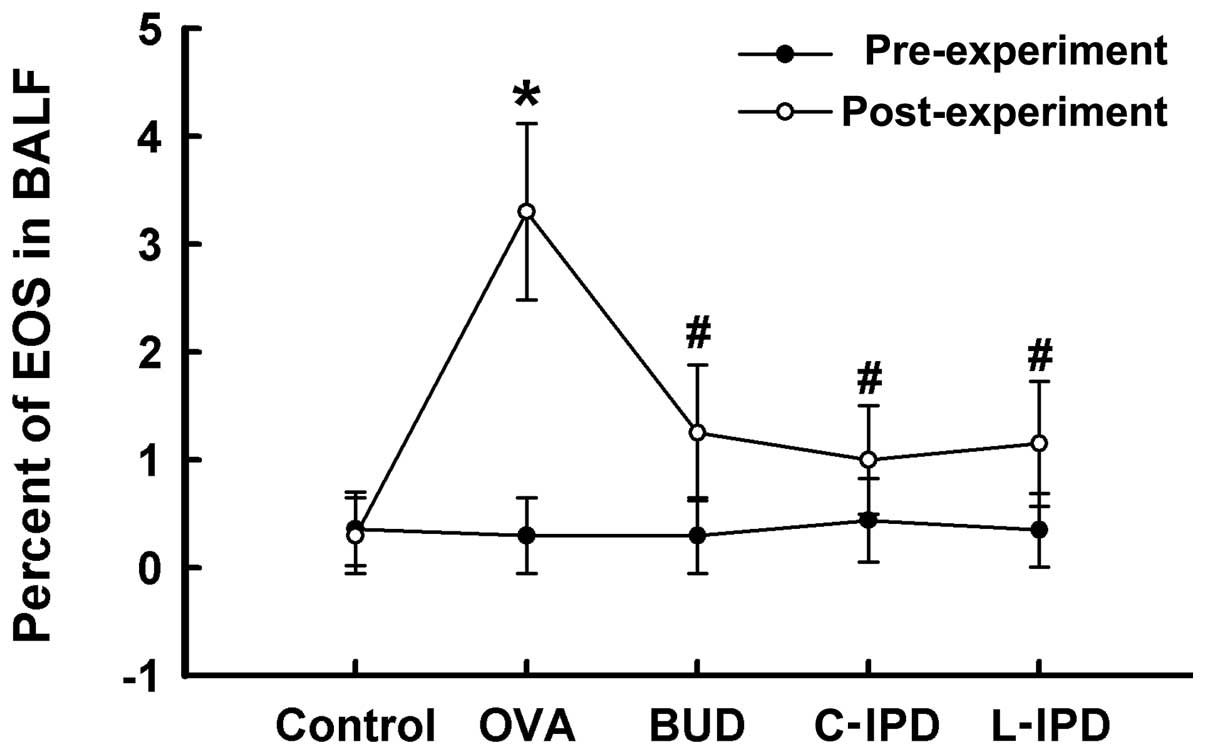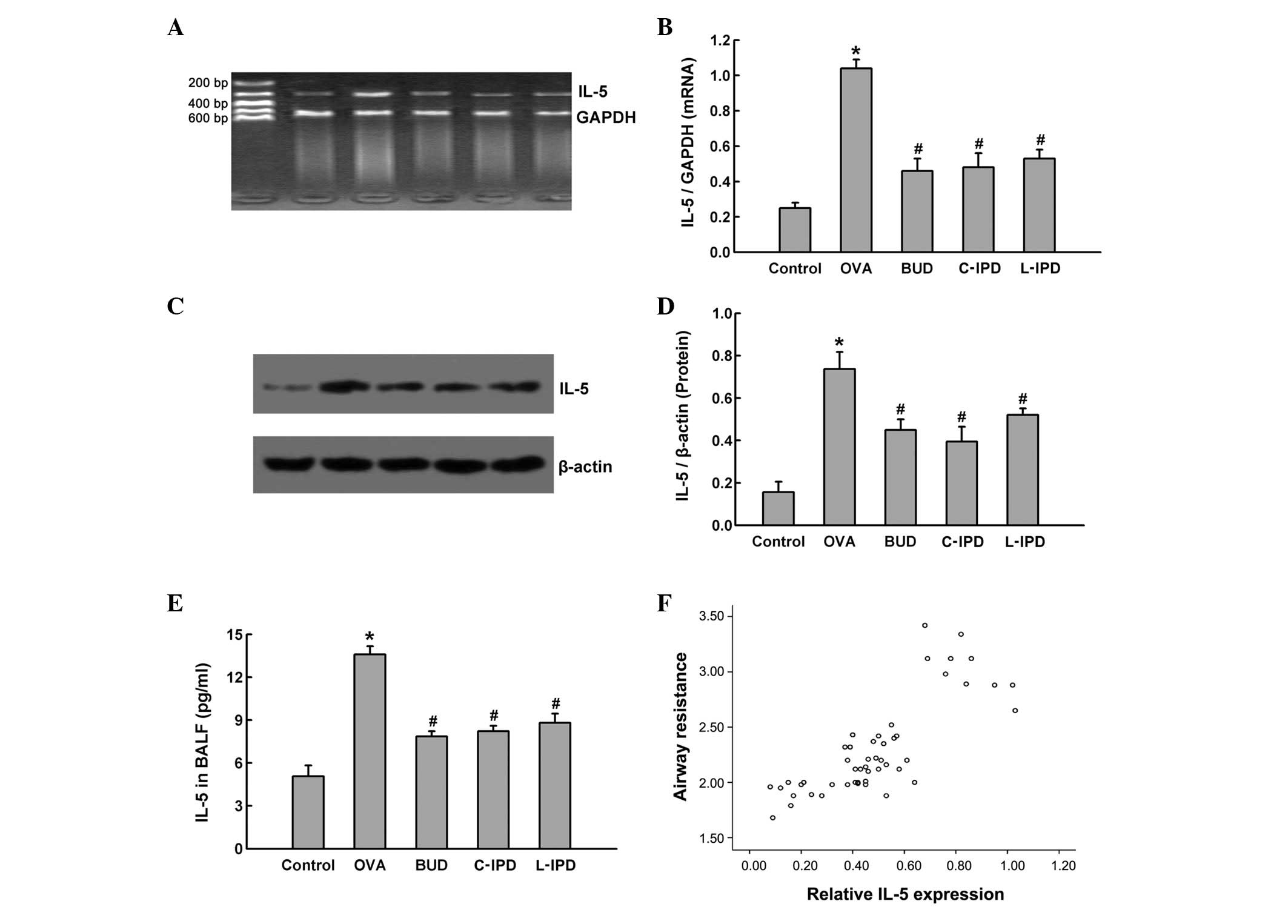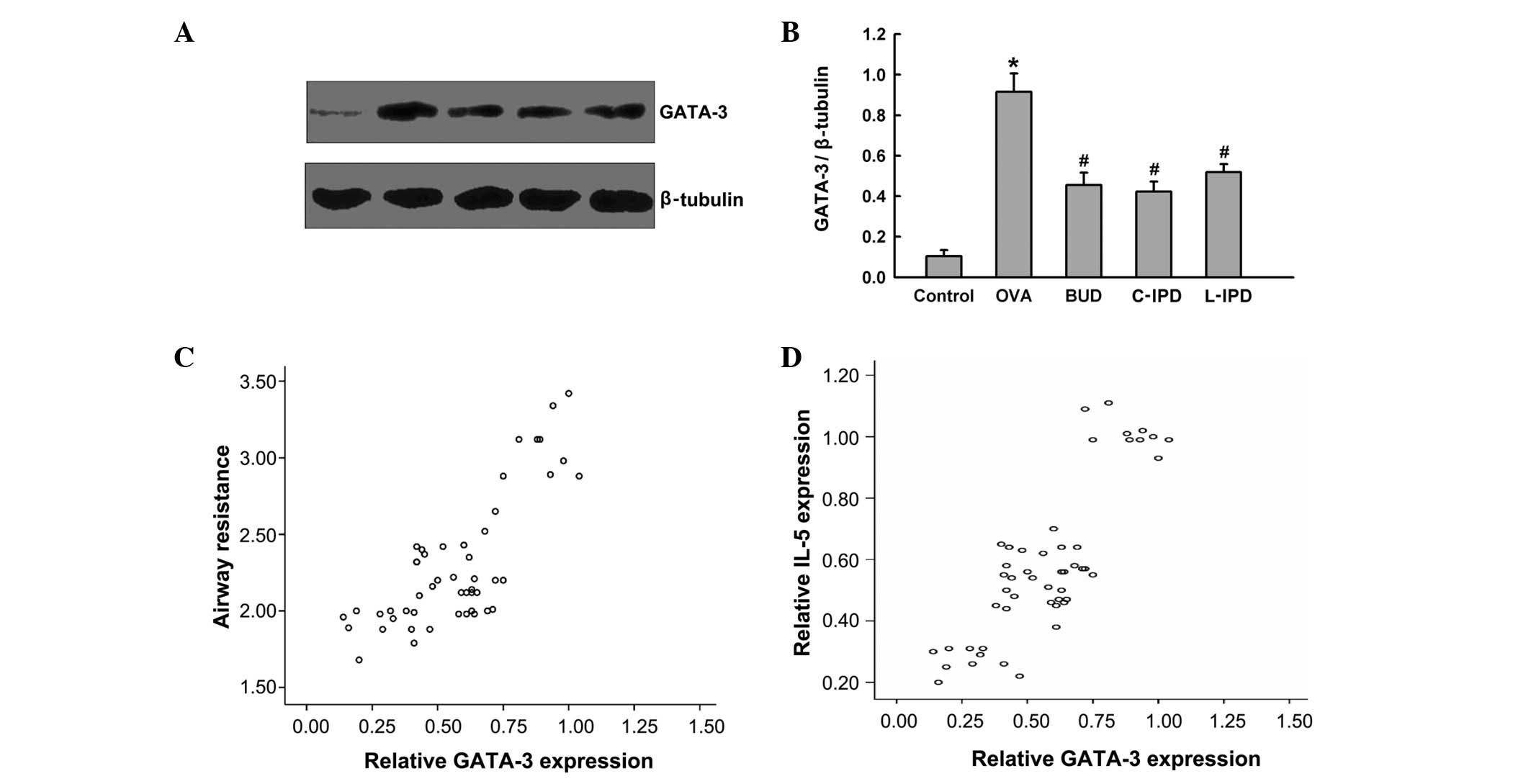|
1
|
Rabinovitch N, Silveira L, Gelfand EW and
Strand M: The response of children with asthma to ambient
particulate is modified by tobacco smoke exposure. Am J Respir Crit
Care Med. 184:1350–1357. 2011. View Article : Google Scholar : PubMed/NCBI
|
|
2
|
Meng W and Busija DW: Comparative effects
of angiotensin-(1–7) and angiotensin II on piglet pial arterioles.
Stroke. 24:2041–2044. 1993.
|
|
3
|
Umetsu DT: Revising the immunological
theories of asthma and allergy. Lancet. 365:98–100. 2005.
View Article : Google Scholar : PubMed/NCBI
|
|
4
|
Foster PS, Hogan SP, Ramsay AJ, et al:
Interleukin 5 deficiency abolishes eosinophilia, airways
hyperreactivity and lung damage in a mouse asthma model. J Exp Med.
183:195–201. 1996. View Article : Google Scholar : PubMed/NCBI
|
|
5
|
Karras JG, McGraw K, McKay RA, et al:
Inhibition of antigen-induced eosinophilia and late phase airway
hyperresponsiveness by an IL-5 antisense oligonucleotide in mouse
models of asthma. J Immunol. 164:5409–5415. 2000. View Article : Google Scholar : PubMed/NCBI
|
|
6
|
Tan GH, Su JM, Wang CC, et al: A
recombinant DNA plasmid encoding the human interleukin-5 breaks
immunological tolerance and inhibits airway inflammation in a
murine model of asthma. Int Arch Allergy Immunol. 145:313–323.
2008. View Article : Google Scholar : PubMed/NCBI
|
|
7
|
Zheng W and Flavell RA: The transcription
factor GATA-3 is necessary and sufficient for Th2 cytokine gene
expression in CD4 T cells. Cell. 89:587–596. 1997. View Article : Google Scholar : PubMed/NCBI
|
|
8
|
Yamashita M, Ukai-Tadenuma M, Miyamoto T,
et al: Essential role of GATA3 for the maintenance of type 2 helper
T (Th2) cytokine production and chromatin remodeling at the Th2
cytokine gene loci. J Biol Chem. 279:26983–26990. 2004. View Article : Google Scholar : PubMed/NCBI
|
|
9
|
Zhu J, Yamane H, Cote-Sierra J, et al:
GATA-3 promotes Th2 responses through three different mechanisms:
induction of Th2 cytokine production, selective growth of Th2 cells
and inhibition of Th1 cell-specific factors. Cell Res. 16:3–10.
2006. View Article : Google Scholar
|
|
10
|
Pai SY, Truitt ML and Ho IC: GATA-3
deficiency abrogates the development and maintenance of T helper
type 2 cells. Proc Natl Acad Sci USA. 101:1993–1998. 2004.
View Article : Google Scholar : PubMed/NCBI
|
|
11
|
Tamaoki J, Takeyama K, Aoshiba K, et al: A
TH2 cytokine inhibitor for airway inflammation in mild asthma. J
Allergy Clin Immunol. 111:197–198. 2003.PubMed/NCBI
|
|
12
|
Sano Y, Suzuki N, Yamada H, et al: Effects
of suplatast tosilate on allergic eosinophilic airway inflammation
in patients with mild asthma. J Allergy Clin Immunol. 111:958–966.
2003. View Article : Google Scholar : PubMed/NCBI
|
|
13
|
Hoshino M, Fujita Y, Saji J, et al: Effect
of suplatast tosilate on goblet cell metaplasia in patients with
asthma. Allergy. 60:1394–1400. 2005. View Article : Google Scholar : PubMed/NCBI
|
|
14
|
Ding L, Zhou X, Yang L, et al: Liquid
chromatography/electrospray ionization mass spectrometry method for
the determination of the active metabolite M-1 of suplatast
tosilate in human plasma. Biomed Chromatogr. 21:1297–1302. 2007.
View Article : Google Scholar : PubMed/NCBI
|
|
15
|
Satoh T, Sasaki G, Wu MH, et al: Suplatast
tosilate inhibits eosinophil production and recruitment into the
skin in murine contact sensitivity. Clin Immunol. 108:257–262.
2003. View Article : Google Scholar : PubMed/NCBI
|
|
16
|
Tanaka A, Minoguchi K, Samson KT, et al:
Inhibitory effects of suplatast tosilate on the differentiation and
function of monocyte-derived dendritic cells from patients with
asthma. Clin Exp Allergy. 37:1083–1089. 2007. View Article : Google Scholar : PubMed/NCBI
|
|
17
|
Agrawal DK, Cheng G, Kim MJ and Kiniwa M:
Interaction of suplatast tosilate (IPD) with chloride channels in
human blood eosinophils: a potential mechanism underlying its
anti-allergic and anti-asthmatic effects. Clin Exp Allergy.
38:305–312. 2008.PubMed/NCBI
|
|
18
|
Tamaoki J, Kondo M, Sakai N, et al: Effect
of suplatast tosilate, a Th2 cytokine inhibitor, on
steroid-dependent asthma: a double-blind randomised study. Tokyo
Joshi-Idai Asthma Research Group. Lancet. 356:273–278. 2000.
View Article : Google Scholar : PubMed/NCBI
|
|
19
|
Matsumoto K, Hayakawa H, Ide K, et al:
Effects of suplatast tosilate on cytokine profile of
bronchoalveolar cells in allergic inflammation of the lung.
Respirology. 7:201–207. 2002. View Article : Google Scholar : PubMed/NCBI
|
|
20
|
Zhao GD, Yokoyama A, Kohno N, et al:
Effect of suplatast tosilate (IPD-1151T) on a mouse model of
asthma: inhibition of eosinophilic inflammation and bronchial
hyperresponsiveness. Int Arch Allergy Immunol. 121:116–122. 2000.
View Article : Google Scholar : PubMed/NCBI
|
|
21
|
Moore RG, Granai CO, Gajewski W, et al:
Pathologic evaluation of inguinal sentinel lymph nodes in vulvar
cancer patients: a comparison of immunohistochemical staining
versus ultrastaging with hematoxylin and eosin staining. Gynecol
Oncol. 91:378–382. 2003. View Article : Google Scholar
|
|
22
|
Yang C, Yang Z, Zhang M, et al: Hydrogen
sulfide protects against chemical hypoxia-induced cytotoxicity and
inflammation in HaCaT cells through inhibition of ROS/NF-κB/COX-2
pathway. PLoS ONE. 6:e219712011.PubMed/NCBI
|
|
23
|
Temelkovski J, Hogan SP, Shepherd DP, et
al: An improved murine model of asthma: selective airway
inflammation, epithelial lesions and increased methacholine
responsiveness following chronic exposure to aerosolised allergen.
Thorax. 53:849–856. 1998. View Article : Google Scholar
|
|
24
|
Karol MH: Animal models of occupational
asthma. Eur Respir J. 7:555–568. 1994. View Article : Google Scholar
|
|
25
|
Vanacker NJ, Palmans E, Pauwels RA and
Kips JC: Dose-related effect of inhaled fluticasone on
allergen-induced airway changes in rats. Eur Respir J. 20:873–879.
2002. View Article : Google Scholar : PubMed/NCBI
|
|
26
|
Maneechotesuwan K, Yao X, Ito K, et al:
Suppression of GATA-3 nuclear import and phosphorylation: a novel
mechanism of corticosteroid action in allergic disease. PLoS Med.
6:e10000762009. View Article : Google Scholar : PubMed/NCBI
|
|
27
|
Tamauchi H, Terashima M, Ito M, et al:
Evidence of GATA-3-dependent Th2 commitment during the in vivo
immune response. Int Immunol. 16:179–187. 2004. View Article : Google Scholar : PubMed/NCBI
|
|
28
|
Yoshihara S, Ono M, Yamada Y, et al: Early
intervention with suplatast tosilate for prophylaxis of pediatric
atopic asthma: a pilot study. Pediatr Allergy Immunol. 20:486–492.
2009. View Article : Google Scholar : PubMed/NCBI
|
|
29
|
Humbert M, Corrigan CJ, Kimmitt P, et al:
Relationship between IL-4 and IL-5 mRNA expression and disease
severity in atopic asthma. Am J Respir Crit Care Med. 156:704–708.
1997. View Article : Google Scholar : PubMed/NCBI
|
|
30
|
Till S, Dickason R, Huston D, et al: IL-5
secretion by allergen-stimulated CD4+ T cells in primary
culture: relationship to expression of allergic disease. J Allergy
Clin Immunol. 99:563–569. 1997. View Article : Google Scholar : PubMed/NCBI
|
|
31
|
Shi HZ, Xiao CQ, Zhong D, et al: Effect of
inhaled interleukin-5 on airway hyperreactivity and eosinophilia in
asthmatics. Am J Respir Crit Care Med. 157:204–209. 1998.
View Article : Google Scholar : PubMed/NCBI
|
|
32
|
Karlen S, Mordvinov VA and Sanderson CJ:
How is expression of the interleukin-5 gene regulated? Immunol Cell
Biol. 74:218–223. 1996. View Article : Google Scholar : PubMed/NCBI
|
|
33
|
Barnes PJ and Adcock IM: Transcription
factors and asthma. Eur Respir J. 12:221–234. 1998. View Article : Google Scholar
|
|
34
|
Yamashita N, Tashimo H, Ishida H, et al:
Involvement of GATA-3-dependent Th2 lymphocyte activation in airway
hyperresponsiveness. Am J Physiol Lung Cell Mol Physiol.
290:L1045–L1051. 2006. View Article : Google Scholar : PubMed/NCBI
|
|
35
|
Szabo SJ, Kim ST, Costa GL, et al: A novel
transcription factor, T-bet, directs Th1 lineage commitment. Cell.
100:655–669. 2000. View Article : Google Scholar
|













